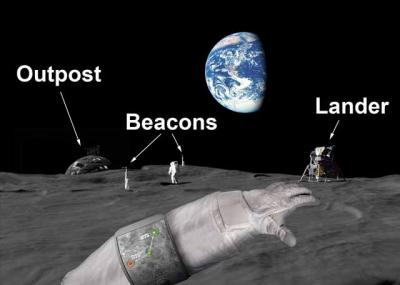
The Crazy Lune

 |
The Crazy Lune |
 |
|---|
      |
|
Link Budget
Technical details:
Center frequency and link bandwidth:
A link carrier frequency of 2.0 GHz was chosen as a compromise between two opposing concerns. Lower frequency operation will reduce the link losses along the path. However, the useful bandwidth of the antenna is limited to a fraction of the carrier frequency. Consequently, at a higher carrier frequency the available bandwidth will be greater. A center frequency of 2.0 GHz will provide ample bandwidth without introducing excessive link loss.
|
|
Independent of power constraints, sufficient bandwidth is a prerequisite for a high bitrate link. As described separately, we have designed an omnidirectional antenna for use at both ends of this link. The antenna was chosen to be omnidirectional in order to allow the astronaut full freedom of motion with respect to the lander without the need for complex mechanical control systems to reliably point a higher-gain directional antenna. The measured antenna performance demonstrates that it offers sufficient gain and negligible return loss for greater than 400 MHz bandwidth. Hence, the bandwidth used in this link will be limited only by the maximum power that can be transmitted, as greater transmit power is needed to compensate for the increase in noise power that accompanies an increase in bandwidth.
Lunar surface propagation model:
To predict the way radio waves are propagated and obtain the path loss of the link on the moon a propagation model is used. A propagation model is a mathematical formula for the characterization of radio wave propagation as a function of frequency, distance, and other condition. Due to the reflections and diffraction off the surrounding terrain environment, RF signals arrives at receiver from different directions with different strengths, time delays, and polarization. This results in different signal strength at one receiver location compare to a short distance away. Due to astronaut is constantly moving from one location to another, significant signal fluctuations may occur depending on surrounding environment. Given that propagation model cannot account for all parameter variations for a practical system it provide a close estimate to the actual system. In general, the path loss can be expressed in dB as Lpath_dB = Lfs + Lmp + Lsh, where Lfs is free-space path loss, Lmp is multipath loss, and Lsh is loss due to shadowing. The free-space path loss depends directly on the frequency and distance between transmitter and receiver. Whereas, multipath loss is difficult to calculate especially for unknown exact geometry of moon surface. The multipath fading term is approximately replaced with a lognormal of 7.5 dB and standard deviation of 1.645 (95%). Finally, slow fading nulls are created by shadowing of the radio signal by obstacles. Terrestrial urban environment value is a good approximate model for slow fading on lunar, since the scale of the rocks and terrain features compared to the lander are comparable to medium sized. The slow fading path loss value used is 14dB with standard deviation of 1.645 (95%) (August 2009, http://wiki.teamfrednet.org/index.php/Rover_calculations_link_budget). The overall expression for the path loss on lunar is as follows: Hence, for frequency of 2.0Ghz and distance of 2km we get overall path loss of 140dB. Path loss can be represented by the path loss exponent, whose value is normally between 2 – 4, where 2 is for propagation in free space and 4 is for relatively lossy environment (November 2009, http://en.wikipedia.org/wiki/Path_loss). To convert the path loss into path loss exponent we used following formula: where n it the path loss exponent and C is a constant which accounts for system losses in this case C is 34 dB. Hence for 2km at 2.0 GHz path loss exponent is 3.2 |
Home | Project | Communication | Location | Power | Budget & Timeline Tuesday, December 8, 2009 © 2009 The Crazy Lune. All rights reserved. |